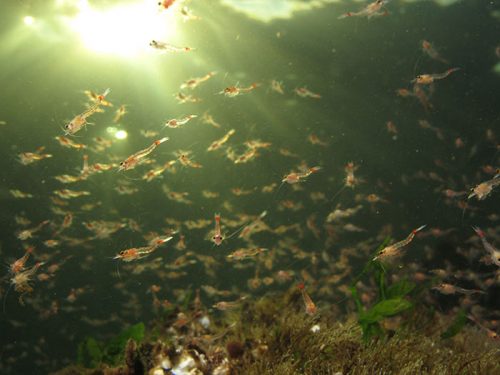 The lesson is divided into 2 parts. The lecture deals with the role and importance of aquatic micro-organisms in the environment and human life. During the course we will learn about the presence of bacteria visible to the naked eye in the Atlantic bottom sediments, bioluminescence microorganisms, plastic and oil digestion capabilities, as well as blue biotech products. Water microorganisms are an invisible power that often resides in environments inaccessible to others. Today, the last passengers on the Titanic are micro organisms. Under laboratory conditions, participants learn about the division of plankton by composition and size fractions, microscopic observation of Atlantic herring larvae, fry and Antarctic krill.
The lesson is divided into 2 parts. The lecture deals with the role and importance of aquatic micro-organisms in the environment and human life. During the course we will learn about the presence of bacteria visible to the naked eye in the Atlantic bottom sediments, bioluminescence microorganisms, plastic and oil digestion capabilities, as well as blue biotech products. Water microorganisms are an invisible power that often resides in environments inaccessible to others. Today, the last passengers on the Titanic are micro organisms. Under laboratory conditions, participants learn about the division of plankton by composition and size fractions, microscopic observation of Atlantic herring larvae, fry and Antarctic krill.
Akwarium Gdyńskie
-
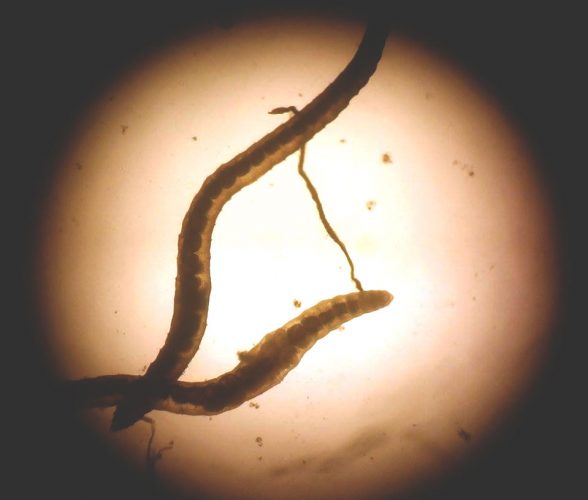
Microscopic world of water bodies
-
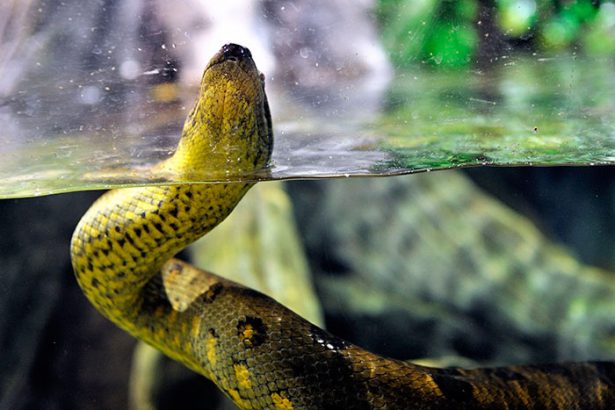
Green anaconda
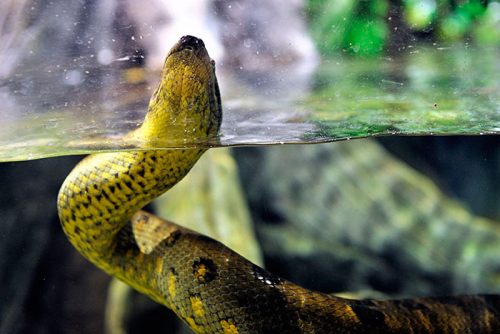 Eunectes murinus
Eunectes murinusLegends about the deadly man-eaters, reaching monstrous dimensions, have often found their reflection in mass culture. Certainly they were the inspiration to create entertainment class B movies. The Green anaconda belongs to the subfamily boa (Boa). It is noteworthy that all anacondas are found only in South America and are viviparous.
The animal leads an amphibious lifestyle. This snake inhabits shallow, slowly flowing freshwater habitats, as well as tropical meadows and rainforests with dense litter. The Latin part of the name Eunectes comes from the Greek language and means “good swimmer”. On land it is slow and sluggish while in water it can reach speeds of up to 20km/h. The Green anaconda has pronounced sexual dimorphism. Males grow up to about 3 meters in length, while females rarely exceed 6 meters and these are cases mainly of captive individuals.
Anaconda definitely doesn’t hunt people. On the contrary. The folklore of indigenous peoples of Brazil and Peru considers this creature magical, which is why body parts are sold for the purpose of performing rituals and treating various ailments. It should be noted that this strangler is one of the few snakes whose body proportions in fact would allow human consumption. However, our body structure, and precisely the shoulder width and width do not allow us to join this reptile’s menu. All snakes in the world swallow their prey starting from the head, so especially for us, the Green anaconda would have to change its current hunting technique. If it comes to meeting a human, the snake will try to bury itself in the litter or mud, or run to the nearest water. If that’s not enough, it will shoot a smelly substance towards the attacker from the anal glands.
The Green anaconda, despite its deadly snake patch, is not really a threat to humans. Scientists agree that the population of this species, although still stable, requires protection. Shrinking habitats, caused by draining wetlands for arable fields and massive felling of forests cause that there is slowly no more place in the world for this snake. Hunting does not help in the condition of the species. Despite its longevity, strong anthropopressure, unfortunately, does not allow these reptiles to grow to a larger size in peace. If this continues the fate of the anaconda, it will inevitably turn out that we will only be able to admire six-meter specimens in zoos. Environmental degradation, as well as man himself, contribute to the fact that the impressive dimensions of this reptile are significantly reduced.
The Green Anaconda is included in Appendix II of the CITES.
-
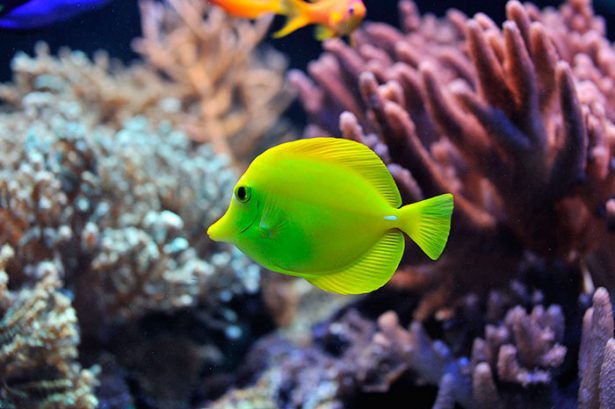
Yellow tang
Zebrasoma flavescens
Order: Perciformes | Family: Acanthuriade
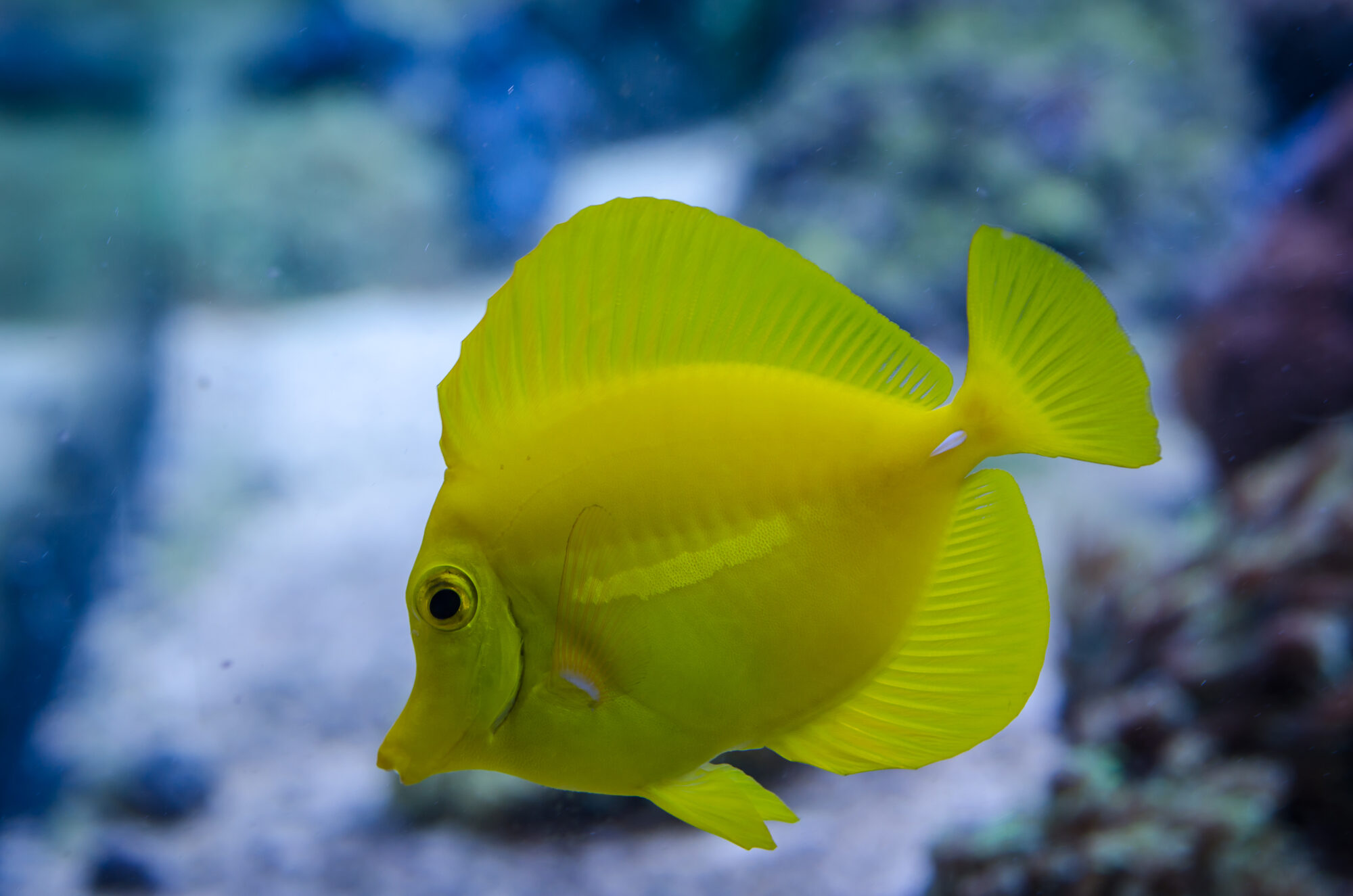
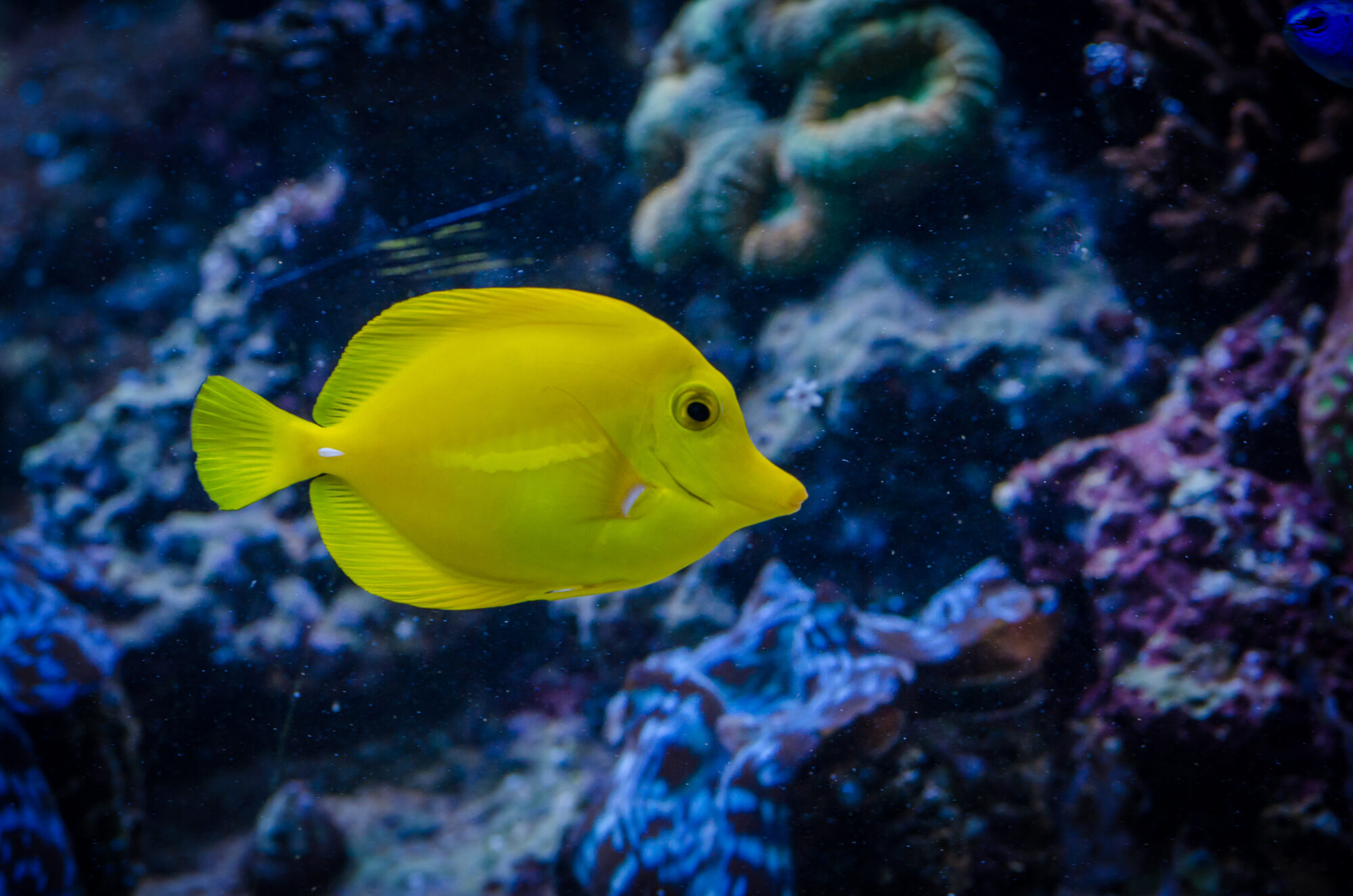
This species can be found in the waters of the Eastern and Southern Pacific Ocean, around the Philippines, Vietnam, Papua New Guinea, Guam, Southern Japan, Micronesia, Hawaii, and the Marshall Islands. It is most prominently found in Hawaii, where it’s used as an aquarium fish. It inhabits regions with a lot of coral and lagoons on the edges of reefs. It is possible to find this fish anywhere from 20 to 40 meters below the surface, but it’s more common to appear around the 20-meter mark. Its sustenance is comprised mainly of algae that grows on corals and the seabed. It has the habit of cleaning the algae that grows on the shells of turtles. It can live longer than 40 years, and it can grow to 20 cm in length. It grows very quickly in the first years of its life; a two-year-old fish can already be 10 cm long. After reaching maturity at around 5 years, the growth slows down heavily. Females reach maturity earlier, at around 3-4 years of age, while males take 4-5 years. As a result, females tend to be smaller. It can be found alone, in pairs, or in small groups in the wild, but it doesn’t stay in those groups for life. It is aggressive towards other representatives of the Acanthuridae family. It’s a very active and curious fish during the day, and at night, it looks for shelter.
The body of the yellow tang has a characteristic vibrant yellow color, which pales during the night, and its sides develop a darker coloring.
Like other Acanthuridae, it has two sharp spikes at the base of its tail to protect itself or to help during battles for territory. It most probably does not have a poisonous gland next to those spikes. It is dioecious and egg-laying. Spawning occurs in pairs or small groups, and it’s tightly connected to the phases of the Moon. Males demonstrate interesting mating dances during spawning.
Daily travels of the yellow tang
There is a distinct division in terms of habitat between juvenile and adult fish. The juveniles inhabit the deeper regions of coral reefs, where they find shelter. After reaching maturity, they change their habitat to shallower regions, which have abundant algae growth and greater biodiversity. The daily migration of juveniles isn’t as extensive as the migration of adults, which can cover even 800 meters between their day and night shelters. They spend their day seeking food in the shallow (<10m) regions rich in algae, and at night, they look for shelter in the deeper parts of the reefs.
-
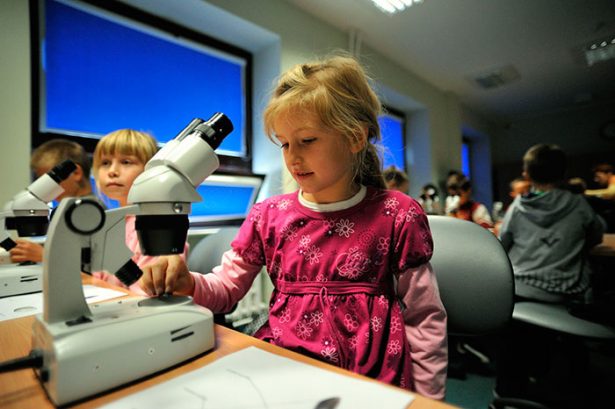
Kashubia on the wave: Bôłt pòd kaszëbską banderą
Classes co-financed by Ministry of Internal Affairs and Administration.
Type of classes: Laboratories
Educational space: Cinema Room, Biological Laboratory, Multimedia Room of Sea Ecology
Maximum number of participants: 24-28
Classes duration: 60 min.
Level: primary school (8-11 years old)
Cost: free
Activities conducted in the form of education through play will transfer children to the ship of the Captain Shorthorn Sculpin, where they will perform tasks related to the environment of the Baltic Sea, which in turn will enable them to acquire further skills.
class=”catlist-nothumbnails” conditional_title=”Other classes from this project:”]
-
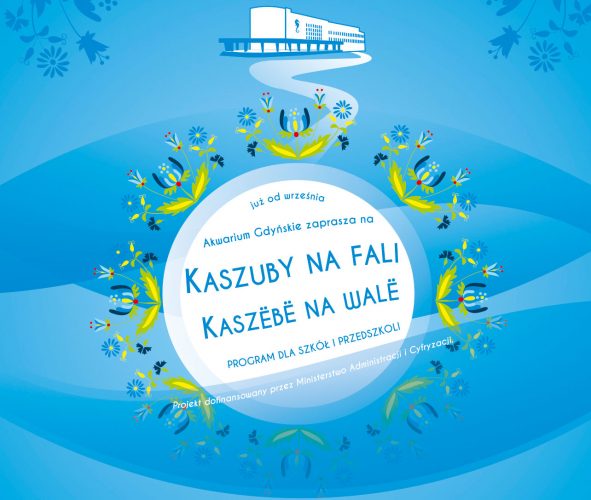
Kashubia on the wave 2017
Classes co-financed by Ministry of Internal Affairs and Administration.
Age group: preschoolers, primary school students
Cost: free
Sign up!
The “Kaszuby on the wave” project, co-funded by the Ministry of Internal Affairs and Administration, is a unique form of natural-language education. In the regional Kashubian language, participants learn about the marine environment. The Kashubian mentality was influenced by the presence of lakes, forests and the sea. Fisheries were – apart from agriculture – a leading occupation of the Kashubian population. That is why it is so important to educate younger generations and to raise awareness of the threats to Baltic fauna and flora caused by human activities.
“Learn to keep” is the slogan of this project. By learning the language, culture, and the world around us, we build a sense of responsibility for the sustainability of our cultural heritage.
Classes are performed by a Kashubian teacher and a specialist responsible for the correctness of the biological content. The Kashubian-Pomeranian Association is our partner in this project.
Classes booking: +48 587 326 620
Project coordinator: Mirosława Raczkowska | +48 587 326 624 | e-mail:mira@mir.gdynia.pl
-
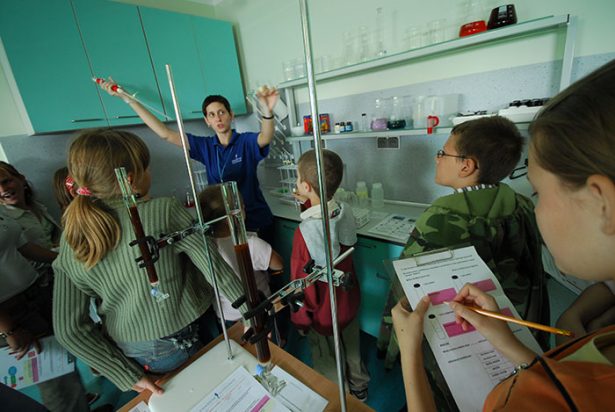
Experimental Water Laboratory
Classes conducted in the Experimental Water Laboratory are complementary to water chemistry education classes. Classes in this room are conducted in groups of 10-12 persons, where participants get familiar with the reverse osmosis process or reduction of its general hardness. Methods of cleaning seawater on the example of a reef aquarium are presented. Additional experiments explain the greenhouse effect and what rainwater really is. Experiments present ways of removing phosphorus from sewage using a model sewage treatment plant. The lesson ends with a multimedia presentation.